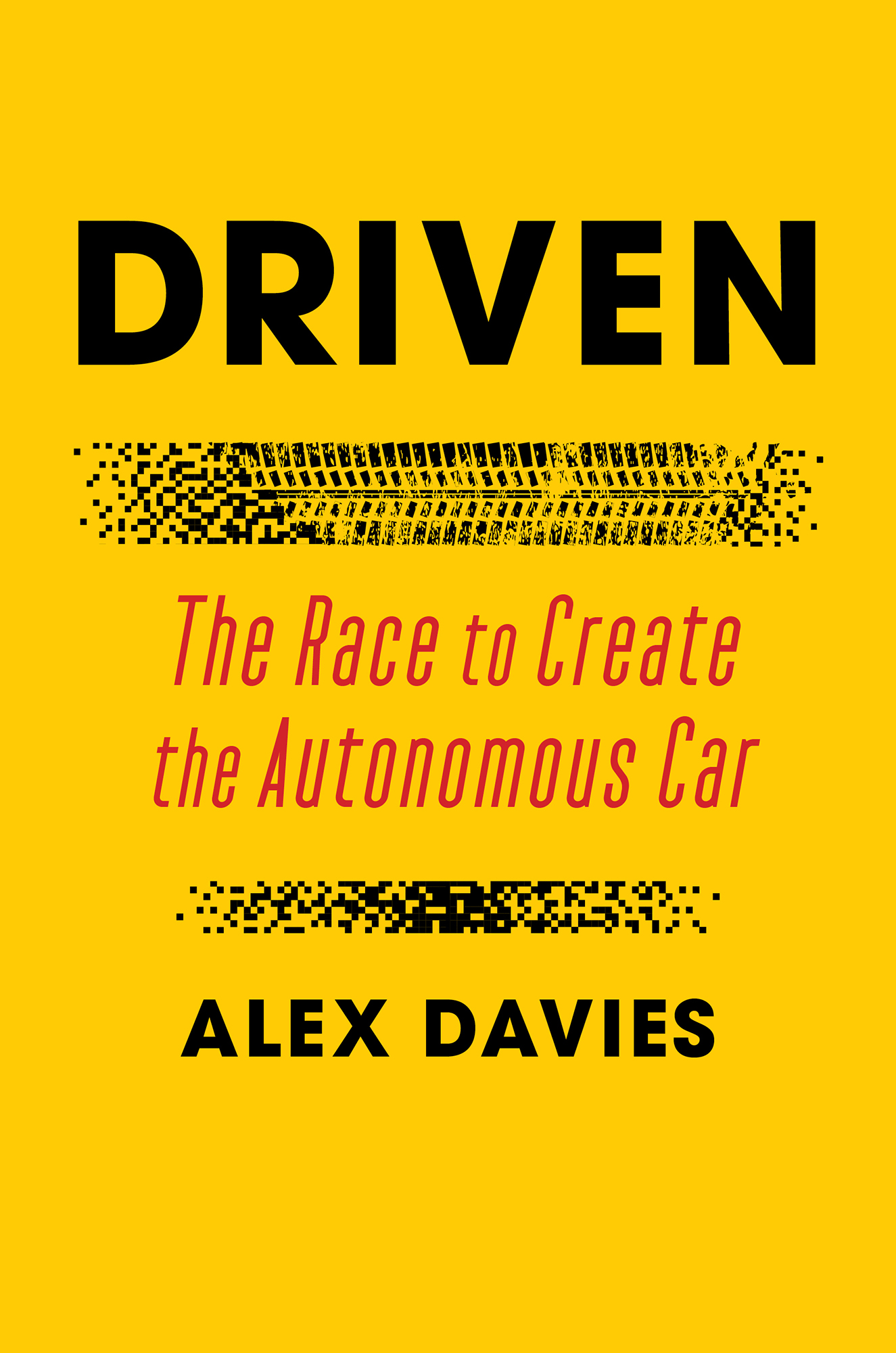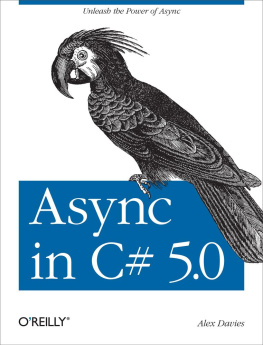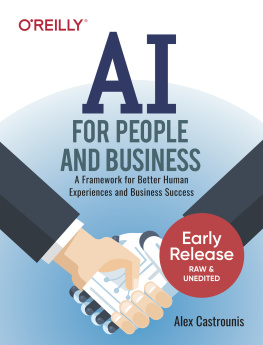Alex Davies - Driven: The Race to Create the Autonomous Car
Here you can read online Alex Davies - Driven: The Race to Create the Autonomous Car full text of the book (entire story) in english for free. Download pdf and epub, get meaning, cover and reviews about this ebook. year: 2021, publisher: Simon & Schuster, genre: Detective and thriller. Description of the work, (preface) as well as reviews are available. Best literature library LitArk.com created for fans of good reading and offers a wide selection of genres:
Romance novel
Science fiction
Adventure
Detective
Science
History
Home and family
Prose
Art
Politics
Computer
Non-fiction
Religion
Business
Children
Humor
Choose a favorite category and find really read worthwhile books. Enjoy immersion in the world of imagination, feel the emotions of the characters or learn something new for yourself, make an fascinating discovery.

- Book:Driven: The Race to Create the Autonomous Car
- Author:
- Publisher:Simon & Schuster
- Genre:
- Year:2021
- Rating:4 / 5
- Favourites:Add to favourites
- Your mark:
- 80
- 1
- 2
- 3
- 4
- 5
Driven: The Race to Create the Autonomous Car: summary, description and annotation
We offer to read an annotation, description, summary or preface (depends on what the author of the book "Driven: The Race to Create the Autonomous Car" wrote himself). If you haven't found the necessary information about the book — write in the comments, we will try to find it.
Driven: The Race to Create the Autonomous Car — read online for free the complete book (whole text) full work
Below is the text of the book, divided by pages. System saving the place of the last page read, allows you to conveniently read the book "Driven: The Race to Create the Autonomous Car" online for free, without having to search again every time where you left off. Put a bookmark, and you can go to the page where you finished reading at any time.
Font size:
Interval:
Bookmark:


For my grandfather, Patrice Lestellea great lover of books and a terrible driver of cars.
Tell me of your country,
Your people, and your city, so our ships,
Steered by their own good sense, may take you there.
Phaeacians have no need of men at helm
Nor rudders, as in other ships. Our boats
Intuit what is in the minds of men
And know all human towns and fertile fields.
They rush at full tilt, right across the gulf
Of salty sea, concealed in mist and clouds.
They have no fear of damages or loss.
Homers The Odyssey
A LITTLE AFTER NINE IN the morning of a cool Friday in April 2017, Anthony Levandowski sat down where so many of his colleagues and friends had predicted he would land himself: in a conference room surrounded by lawyers, being grilled about his starring role in the first great battle of a world he had helped create.
If the blinding morning sun hadnt been coming through the window of the twenty-second-floor office in downtown San Francisco, Levandowski would have been able to see the Bay Bridge. Every day, 260,000 vehicles used the 8.4-mile span to cross the bay that divided the city from Oakland, Berkeley, and the rest of its East Bay neighbors. By six in the morning, the mass of cars, trucks, vans, and motorcycles waiting to pay the ever increasing toll and funnel onto the crossing created a mile-long parking lot. On days when someone crashed on the bridge, the resulting extra congestion could cripple the regions road network. Like eighteenth-century urbanites emptying chamber pots from upper story windows, it was a quotidian sort of insanity, excused by entrenchment and a lack of better options.
Attorney David Perlson, of the white shoe law firm Quinn Emanuel Urquhart & Sullivan, began the deposition. Where do you work currently?
I work at Uber, Levandowski said.
Six feet six inches tall and slim, with a head of dark hair that was starting to recede, Levandowski wore a blue suit for the occasion, no tie. Apart from the black sneakers, it was a rare change from the standard Silicon Valley engineer look he embraced: jeans and whatever T-shirt was on top of the dresser drawer that morning.
Okay, Perlson said. And whats your position there?
Im vice president of engineering.
What are your responsibilities as vice president of engineering?
Here, at the direction of his lawyer, Levandowski read from a piece of paper on the table in front of him.
On the advice and direction of my counsel, I respectfully decline to answer, Levandowski said. And I assert the rights guaranteed to me under the Fifth Amendment of the Constitution of the United States.
How long have you worked at Uber?
On the advice and direction of my counsel, I respectfully decline to answer. And I assert the rights guaranteed to me under the Fifth Amendment of the Constitution of the United States.
Over the following six hours, Levandowski declined to answer one question after another, questions that in their one-sidedness built a damning narrative.
When you worked at Google, you received tens of millions of dollars in compensation from Google, is that accurate?
You and Uber discussed how you would form a new company while you were employed by Google?
You and Uber discussed that your new company would eventually be acquired by Uber while you were still employed at Google?
That new company eventually became Otto, correct?
While you were still employed by Google, you recruited engineers to join your new company so that your new company could replicate Googles Lidar technology, correct?
You took over fourteen thousand confidential files from Google prior to your departure from Google, correct?
You took the fourteen thousand documents from Google so that you could getso that you could more quickly replicate Googles technology at Otto, correct?
Mr. Levandowski, your use of the fourteen thousand confidential documents you took from Google allowed you to sell Otto to Uber for over $680 million in just a few months?
Again and again and again, Levandowski gave his carefully scripted nonanswer, citing his Fifth Amendment rights.
Officially speaking, Levandowski was just one of many witnesses being deposed in the run-up to Waymo v. Uber, a legal brawl between two corporate giants. Waymo had started life as a Google project called Chauffeur, and was now its own company under the umbrella of Googles parent company, Alphabet. Uber was the enormously valuable ridehailing company that had thrown the world of urban transportation into chaos since its founding in 2009. Both were racing to create and deploy cars that could drive themselves.
Their fight centered on the thirty-seven-year-old Levandowski, who had spent nine years at Google before moving to Uber. In Waymos telling, on December 14, 2015, Levandowski downloaded more than fourteen thousand technical files from its servers onto his laptop, many of them describing the inner workings of its all-important Lidar laser vision system. He connected an external hard drive into the computer for eight hours, then installed a new operating system to wipe away evidence of the downloads. He quit six weeks later and founded Otto, a company dedicated to developing self-driving trucks. After a few months, Uber acquired Otto for a reported $680 millionan astounding figure for such a young companyand put Levandowski in charge of its own autonomous driving project.
Under Levandowskis direction, Waymo alleged, Ubers engineers used those files to accelerate their technical progress and play catchup, having started their research only in 2015, six years after Google. That, Waymo insinuated, was why Uber had been able to send robotic trucks along the highways of Colorado and Nevada, how it was using robotic cars to move people around Pittsburgh. Those vehicles still had people behind the wheel, but it was only a matter of timetime better counted in months than yearsbefore the flesh-and-blood backups were no longer necessary.
Uber said that nothing Levandowski may have taken made its way into its work.
If Waymos phalanx of lawyers convinced the jury that Uber had cheated to get ahead, Uber could be forced to put its autonomous driving efforts on ice, or maybe the scrap heap. And that wouldnt be just a hit to the balance sheet. It would be an existential crisis. Driverless cars would be safer and cheaper than human-driven ones, and any service that provided them would dominate the market, said Uber CEO Travis Kalanick. In order for Uber to exist in the future, we will likely need to be a leader in the AV, autonomous vehicle, space.
Kalanick was right. Robots will drive the future. By the start of the Waymo v. Uber trial in February 2018, fleets of autonomous vehicles were roaming the streets of Silicon Valley, San Francisco, Pittsburgh, Phoenix, Detroit, Boston, Munich, and Singaporeto name a few. Tesla, Cadillac, BMW, Audi, Mercedes-Benz, Nissan, and other automakers were selling cars that could pilot themselves on the highway. Along with Google and Uber, Ford, General Motors, and others were working on fully driverless cars that wouldnt need steering wheels or pedals. Dozens of companies, from the worlds largest corporations to the smallest startups, were crowding into a technology whose upside flirted with utopianism. The average American worker spent nearly an hour driving to and from work every day; driverless technology would turn that chore into free time. Robots that never get drunk, tired, angry, or distracted promised to drastically reduce crashes, more than 90 percent of which result from human error. Those crashes kill about forty thousand Americans every year. Globally, the annual death toll is well over a million.
Font size:
Interval:
Bookmark:
Similar books «Driven: The Race to Create the Autonomous Car»
Look at similar books to Driven: The Race to Create the Autonomous Car. We have selected literature similar in name and meaning in the hope of providing readers with more options to find new, interesting, not yet read works.
Discussion, reviews of the book Driven: The Race to Create the Autonomous Car and just readers' own opinions. Leave your comments, write what you think about the work, its meaning or the main characters. Specify what exactly you liked and what you didn't like, and why you think so.











